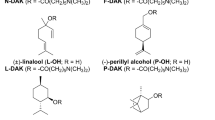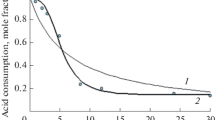Abstract
The carboxylic ester hydrolase activity was compared in athymic nude mouse skin and hairless mouse skin with respect to hydrolytic ability, heat inactivation, pH optima, and substrate specificity. Five aliphatic 5′-esters of 5-iodo-2′-deoxyuridine (IDU) were incubated with skin homogenate preparations, and the effect of linear chain length and branching of the ester substituent on hydrolysis rate was evaluated. The ester hydrolase activity was three times higher in athymic mouse skin relative to hairless variety. In both mice skin preparations maximum hydrolysis rates were obtained with the valeryl ester followed by butryl, isobutyryl, propionyl and pivaloyl derivatives. Kinetic studies, however, revealed that higher ester hydrolase activity (V max) in athymic mouse skin is also associated with higher K m values, while the carboxylic ester hydrolases from these two different strains of mice have similar biochemical properties with respect to heat inactivation and pH optima. Athymic mouse skin resembled hairless mice skin in terms of cholinesterase content. A significant fraction (70–80%) of ester hydrolyzing activities in both strains of mice skin resulted from cholinesterases (true and/or pseudo). The remaining activity was attributed to different ester cleaving enzymes in the two strains of mice. Carbonic anhydrases and arylesterases contributed to the ester hydrolyzing activity of the athymic and normal hairless mice skins, respectively. Product inhibition by the regenerated hydrolytic product, free IDU, was also noticed which resulted in incomplete conversion of rapidly hydrolyzable 5′-esters such as the valeryl and butyryl derivatives.
Similar content being viewed by others
REFERENCES
K. Hopkins, L. Aarons, and M. Rowland. In M. A. Weber and C. J. Mathias (eds.), Current Controversies and New Approaches, Steinkoff Verlag, Darmstadt, 1984, pp. 143–147.
W. R. Good. Drug Dev. Ind. Pharm. 9:647–670 (1983).
J. E. Shaw and S. K. Chandrasekharan. Drug Met. Rev. 8:223–233 (1978).
J. Kao, J. Hall, and J. M. Holland. Toxicol Appl. Pharmacol. 68:206–217 (1983).
S. K. Chandrasekharan, W. Bayne, and J. E. Shaw. J. Pharm. Sci. 67:1370–1374 (1978).
M. S. Robert, R. A. Anderson, and J. Swarbrick. J. Pharm. Pharmacol. 29:677–683 (1977).
H. Mukhtar and D. R. Bickers. Drug Metab. Dispos. 11:562–576 (1983).
W. A. Khan, M. Das, S. Stick, S. Javed, D. R. Bickers, and H. Mukhtar. Biochem. Biophys. Res. Comm. 146:123–126 (1987).
Y. Ozawa, I. Koyama, S. Murayama, and T. Nadai. Chem. Pharm. Bull. 33:5113–5118 (1985).
W. Wiegrebe, A. Retzow, E. Plumier, N. Ersoy, A. Garbe, H. P. Faro, and R. Kurnet. Arzneim-Forsch. 34:48–51 (1984).
A. S. Hua, N. F. H. Ho, N. Husari, G. L. Flynn, W. E. Jetzer, and L. Condie. Arch. Environ. Contam. Toxicol. 15:557–566 (1986).
E. Touiton and L. Abed. Int. J. Pharm. 27:89–98 (1985).
A. S. Susten, B. L. Dame, and R. W. Niemeyer. J. Toxicol. 6:43–46 (1986).
B. T. Nghiem and T. Higuchi. Int. J. Pharm. 44:125–130 (1988).
N. D. Reed and D. D. Manning. Proc. Soc. Exp. Biol. Med. 143:350–355 (1973).
J. Ryguard. Acta Pathol. Microbiol. Scand. 82:105–111 (1974).
G. G. Krueger, D. D. Manning, J. Malout, and B. Ogden. J. Invest. Dermatol. 64:307–312 (1975).
J. W. Streilein. J. Invest. Dermatol. 71:167–171 (1978).
N. V. Sheth, M. B. McKeough, and S. L. Sprunace. J. Invest. Dermatol. 89:598–602 (1987).
M. M. Narurkar and A. K. Mitra. Pharm. Res. 5(11):734–739 (1988).
O. H. Lowry, N. J. Rosebrough, and A. L. Farr. J. Biol. Chem. 193:265–274 (1957).
M. Dixon and E. C. Webb. In P. D. Boyer (ed.), Enzymes, 3rd ed. Academic Press, New York, 1979, pp. 231–270.
B. H. J. Hofstee. J. Biol. Chem. 201:219–222 (1956).
V. H. L. Lee. J. Pharm. Sci. 72:239–244 (1983).
C. H. Walker and M. I. Mackness. Biochem. Pharmacol. 32:3265–3271 (1983).
T. Weinker and O. V. Deimling. Biochem. J. 246:559–563 (1987).
H. Krisch. In P. D. Boyer (ed.), Enzymes, 3rd ed., Academic Press, London and New York, 1971, Vol. 5, p. 43.
B. N. LaDu and H. Snedy. In B. B. Brodie and J. R. Gillette (eds.), Handbook of Experimental Pharmacology, Vol. 20, Pt. II, Springer-Verlag, New York, 1971, p. 477.
Author information
Authors and Affiliations
Rights and permissions
About this article
Cite this article
Ghosh, M.K., Mitra, A.K. Carboxylic Ester Hydrolase Activity in Hairless and Athymic Nude Mouse Skin. Pharm Res 7, 251–255 (1990). https://doi.org/10.1023/A:1015869911576
Issue Date:
DOI: https://doi.org/10.1023/A:1015869911576




